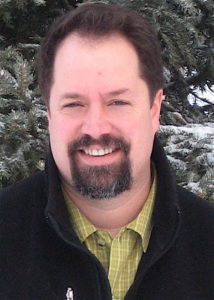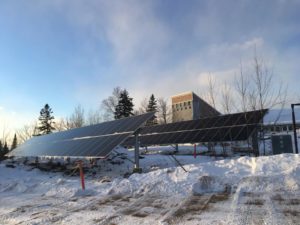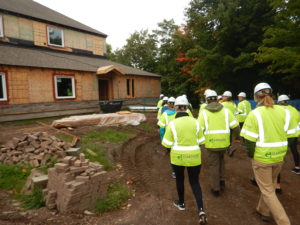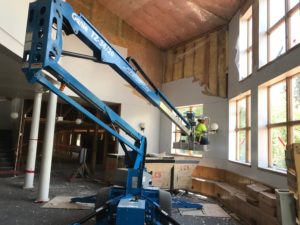Tap into the collective power of influential business and NGO pioneers to create new strategies and
tactics to build a more socially and environmentally conscious state.
Tap into the collective power of influential business and NGO pioneers to create new strategies and
tactics to build a more socially and environmentally conscious state.
The U.S. Green Chamber of Commerce is excited to bring you this series of sustainability leaders who are making a positive impact in Minnesota. Meet the people who are working to improve the environment in Minnesota and around the world. Click here to view all of our Minnesota Leaders.
Peter Smerud
Title:
Executive Director
Company or NGO Name:
Wolf Ridge Environmental Learning Center
Region or City:
Finland, MN

1. What is the mission of your company/NGO?
To develop a citizenry that has the knowledge, skills, motivation, and commitment to work together for a quality environment.
2. What is the most innovative or environmentally/socially impactful project/practice your company/NGO has implemented?
Wolf Ridge recently renovated our original dormitory to the highest international standard of sustainability, constructing to full certification of the Living Building Challenge. This is the first ever in MN, WI, ND, and SD, and one of less than 50 in the world to design and build to full certification. This will not simply be a model, rather it will serve as a living and learning experience of sustainability for thousands of children for decades to come.
3. How have those projects positively impacted the local community or state?
Schools from over 100 communities in Minnesota and thousands of families send their children to Wolf Ridge each year, and have done so for 47 years, resulting in 13,000 Minnesotans who annually live and learn at Wolf Ridge. Wolf Ridge is a breakthrough experience for children and families that are developing the environmental ethic for which Minnesotans are famous. The new Margaret A. Cargill Lodge is a teaching tool of sustainability. As a net zero energy and water building, the occupants residing within will see their energy and water use in real time, making minute by minute choices of sustainability and learning how to live net zero. They will learn that is possible to construct buildings at a higher level of social responsibility and that live more in balance with nature.
A process of two years was needed to find and build the team of contractors and manufacturers to construct this series of projects. With no contractor in the state having done this level of work, Wolf Ridge, supported by Gardner Builders and HGA Architects and Engineers, raised the bar and the collective skill set of more than two dozen contracting companies through the state. From this project many true firsts occurred for the central portion of our continent, for example, the development of the first: LBC compliant paint that is free of red list chemicals, LBC compliant windows, roof trusses and siding manufactured to Forest Stewardship Council (FSC) standards, and many more examples.
4. Please share any new projects you will be implementing in the near future.
Wolf Ridge has acquired 68 acres of land on the Lake Superior shoreline where we will ensure future generations of Minnesotans have a deeper connection to and understanding of Lake Superior. Minnesotans have an obligation to the world to assure our care of Lake Superior is at the highest of levels. Connecting future generations to our surface freshwater is enriched at Wolf Ridge by doing the same with our food systems. Wolf Ridge broke ground on an organic farm that will supply vegetables for the 144,000 meals annually served at the center while also modeling and building a local food system that supports food sustainability in northeastern MN. Children and adults at Wolf Ridge participate in the farming process, learning where their food comes from and how as Minnesotans we can live more sustainably through our choices.
5. What are the biggest challenges you have faced when pursuing or trying to promote sustainable practices/projects?
The remoteness of our location, challenge of our climate, contractors without experience at this level, and the lack of materials in the central portion of our continent that meet sustainability standards. For many projects it is finding the community or team of people that believes it can be done and does not put up walls or start by saying no.
 6. What are your top 3 career accomplishments?
6. What are your top 3 career accomplishments?
Leading the most diverse and largest accredited residential environmental learning center in the nation.
Leading a process and team to the creation of the region’s first building to design and construct to full certification of the highest international standard of sustainability, the Living Building Challenge.
Development of a wilderness environmental education program at Wolf Ridge that connects hundreds of children each year to several of the greatest natural treasures in this region, from the BWCAW to Lake Superior.
7. What inspired you to choose your career path?
Experiences in the outdoors enabled through Boy Scouts as a youth, a program of field biology learning as an undergraduate student with tremendous mentors at Concordia College, Moorhead, and experiential learning experiences at the National Outdoor Leadership School and Wolf Ridge Environmental Learning Center as a graduate student.
8. Personally—Why do you care about sustainability? What is your story?
The future of humans on the planet is directly tied to how connected we are to natural systems and our behaviors affect the planet. I was raised with deep meaningful experiences in the outdoors, camping, hunting, and a lifestyle that created a feeling of connection to wild and beautiful places. Then studying Biology and Chemistry in college bonded that connection with scientific knowledge. Environmental education is the act of joining science learning together with an interactive experience of humans examining their behaviors. Wolf Ridge is the place where gaining knowledge about the outdoors meets inspiration and is manifested in a changed community of people. These experiences changed my life and annually do the same for thousands of children and families at Wolf Ridge.
9. What do you think are your biggest strengths as a leader in Sustainability?
I haven’t gone to school to learn about sustainability, rather I’ve been raised through the learning experiences, as a child outdoors, to a student of science, a field educator and naturalist, a participant in construction of an entire facility dedicated to environmental learning, and now leading the creation of human behaviors, social systems, and sustainability processes that have stepped up to the highest level of sustainability, the Living Building Challenge. I can talk, because I’ve walked the walk, learning theory and methods, construction methods and standards, ecological systems and diversity, renewable energies, and more… from years of being immersed in them and actively performing them.
10. What is/are the biggest incentive(s) for businesses in your area to adopt sustainable practices?
To leave a legacy by being a part of changing the world to be a better place.
Economic development opportunities that “green” construction methods.
Adopting sustainable practices is at the same time developing greater resiliency, which is something from which every business can benefit.
Considering our actions and making wise choices, now, are an act of support for the generations that will follow us. If we ask, “will this assure that my grandchildren will be in a better place than I am now”, that will enable a stronger future for us all.
11. What is/are the biggest environmental or social challenge(s) facing Minnesota today?
A population of young people, our future generation, growing increasingly disconnected from nature and science.
The need to see education and learning occur with higher levels of engagement for our children and college students, using experiential methods in authentic settings and supporting schools and teachers to make that happen.
The changing values and beliefs surrounding the understanding of science and scientific process.
Changing climate and our inability to adapt fast enough, along with the need to commit to positive behavior changes that will enable success on a planet that behaves differently than what we’ve had.
12. What is the most positive action Minnesota has taken to positively impact its environment or social wellbeing?
Minnesota is the top leader amongst states of this country in environmental education. While many states have strong outdoor recreation and environmental ethic identities within their citizenry, Minnesota’s commitment to environmental education in unmatched and ubiquitously embedded in all sectors of our society. No other state rivals our network of nature centers, nature and science based museums, accredited residential environmental learning centers and summer camps. Combined with government, youth and community organizations, faith based communities and many more, we’re creating a statewide community of people interacting and working collaboratively toward a more environmentally literate citizenry. The presence of such networks, and the demand by the people and educators of MN for these entities is evidence of the state’s commitment to our collective environmental and social wellbeing.
Bonus Questions:
1. What are your thoughts on climate change? What is your company/organization doing to help bring awareness or to help mitigate climate change?
It is one of the greatest and most important issues our society is facing. Years ago Wolf Ridge added coursework where students now study: Climate Change, Energy In My Home (a conservation and efficiency class), and Renewable Energy. All of these classes include elements of direct focus on the subject and/or connections to how we can improve our behaviors to address climate change.
2. How dedicated are Minnesota’s businesses to corporate social responsibility? List some practices you think would be helpful.
I believe a tremendous number of businesses are extremely dedicated. Corporate social responsibility, can be and is good business. From creating systems that support positive, rewarding lifestyles for your employees, to minimizing your impact on the planet, these moves help to attract employees as well as customers, while also building resiliency for your business.
3. What has been the most enjoyable part of your role/position/career?
Teaching children, with their parents, out in the woods and waters of Wolf Ridge Environmental Learning Center. It is tremendously empowering to see a child enthralled by some moss, an insect they’ve found in the water, or in their achievement of a high ropes course. The parent stands in pride with huge smile, the child races up to them to tell of their experience, and the teacher who facilitated stands back and thinks… this is all it takes to change the world. I love it!
To learn more about the Wolf Ridge Environmental Learning Center, visit: